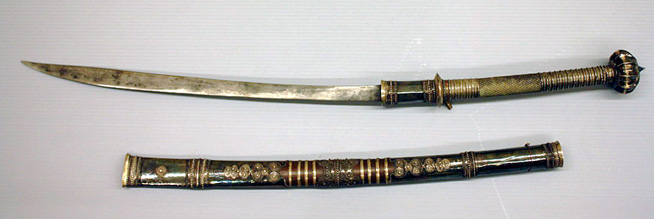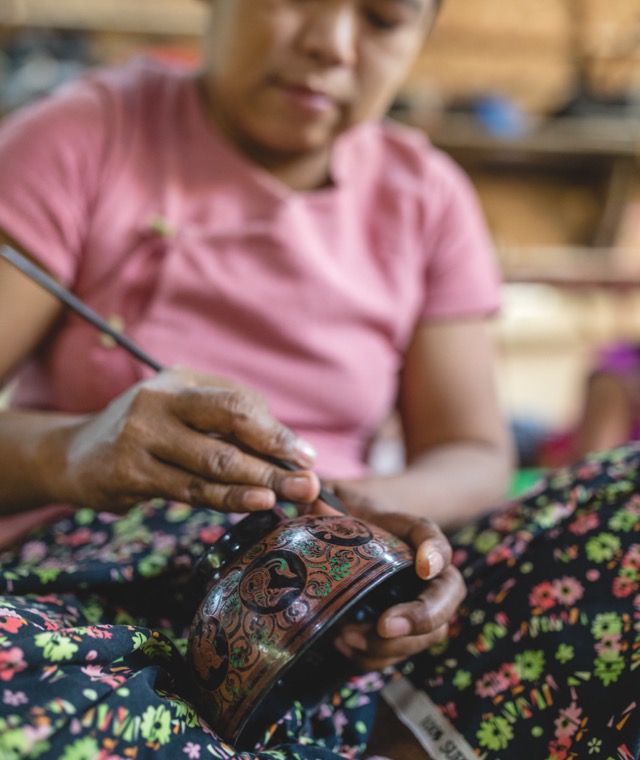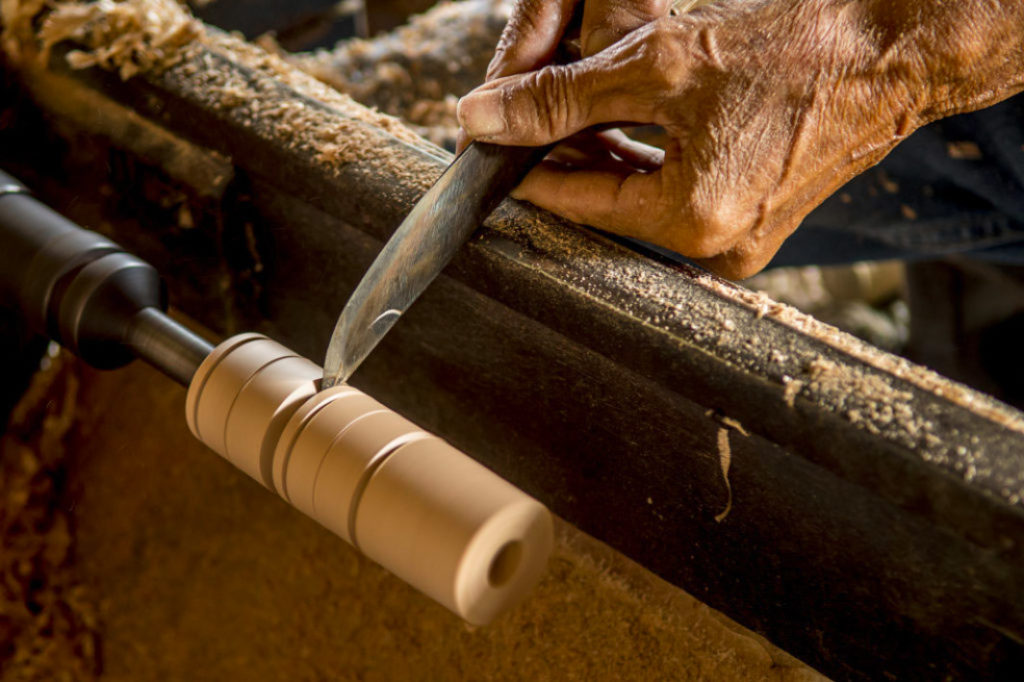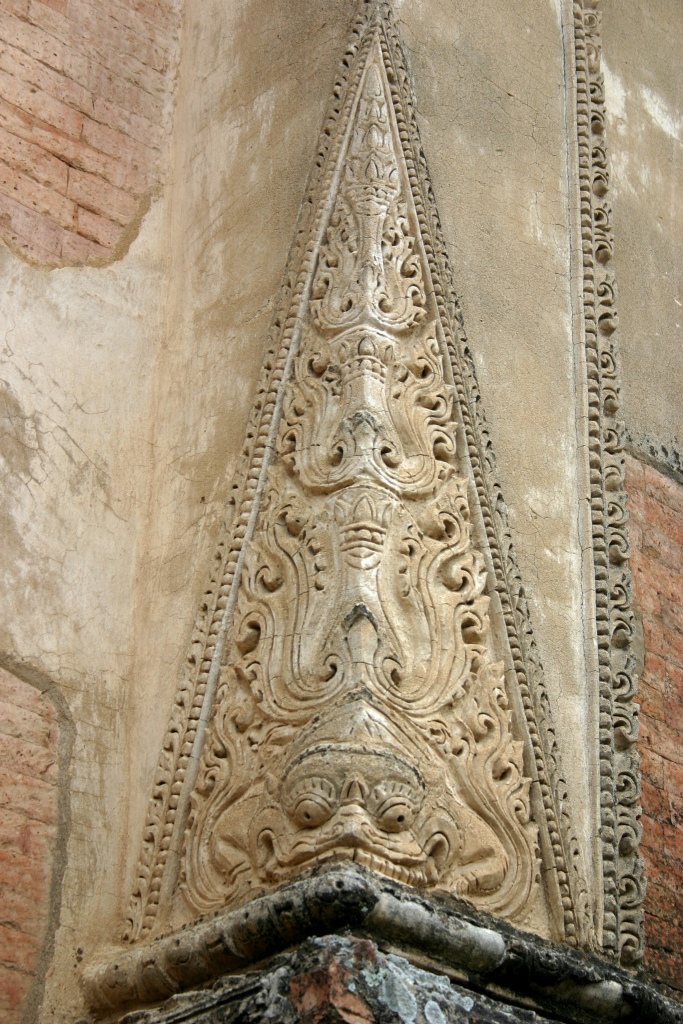1. Panchi (ပန်းချီ), the Art of Painting.
Pronounced as “Bagyi”. The most famous Myanmar painters illuminated religious texts using palm leaves paper.


2. Punpu: the Art of Sculpture.
Pronounced as “ Bapu”. Sculptures in Myanmar has been made traditionally out of wood and stone. The art developed greatly during the Bagan Era. Buddhas, flowers, plants and humans are the main motifs, in many in religious buildings, pagodas, monasteries and houses.


This video is great, it shows the incredible wood carving work in the Golden Palace Monastery in Mandalay… so beautiful and such a great effort of experts and craftmen.
3. The Art of Panbe (ပန်းပဲ)
Pronounced as “Babear”. This is the art of blacksmithing or forging metal where the artisans use ahammer and an anvil to transform iron into hoes, pick axes, axes, swords and armor and the metal part of ox cart wheels.


Just so you get an idea of what it takes to make something like that sword, take a look at this video:
I am in awe… the strength that takes!
The Art of Panyun
Pronounced as “Payun”. This is the art of making lacquerware. Artisans make boxes, vases, bowls, drinking cups, etc. with bamboo, teak wood or weaved horse hair. Then they are covered in a thick, black varnish known as “sis-se” that comes from the sap of trees. Images are carved once it has been dried and polished. Then colored in. It is a lot of work as to get multiple colors you must protect each layer and then carve again for the next color.





This wonderful video has the entire process:
5. The Art of Panput (ပန်းပွတ်)
Pronounced as “Baput”. It is the art of making materials by rubbing and turning woods on the lathe turner. Craftsmen make the shafts for umbrellas, table legs, the legs of beds, rotary seats and halls and stairs railings.



The Art of Panyan (ပန်းရန်)
Pronounced as “Payan”. it is the art of masonry, constructing buildings with brick, stone, concrete and cement. The masons build brick houses, pagodas, bridges, etc.


The Art of pantaut (ပန်းတော့)
It is the art of creating stucco relief on ceilings, doorways, on figures of lions, dragons, etc. Stucco can be made of cement, sand and limestone or mixtures of these, a binder, and water which is applied wet, and hardens when it dries.



Here is a video that shows the process:
7. The Art of Pantamaut (ပန်းတမော့)
It is the art of carving stone. Artisans make buddha images, pillars, elephants, deers, mortars, tables, etc.
One of the most famous sculptures in Myanmar ever created is a Buddha called Maha Thetkya Mayazein (မဟာသကျမာရဇိန်). The sculpture was made out of a single block of marble. It is 25 feet (7.6 m)!!! It weighs around 560 tons. Imagine that it took about 10,000 people to transport it to the temple. It was made during the reign of King Mindon (r. 1853 – 78) and is located at the Kyauktawgyi Paya Temple in Mandalay.

Here is a video of a tourist walking in to see it… in it you get a sense of how big it really is!


9. The Art of Patain (ပန်းထိမ်)
Pronounced as “Badain”. It is the art of making objects form gold, silver, bronze, brass or copper. These artists make containers, cups, religious objects, etc.


10. The Art of Pante (ပန်းတဉ်း)
It is the art of creating objects from bronze, copper, brass. Artisans make gongs, bells, pots, trays, boilers, cup bowls, dishes and cymbals.






I’m so impressed with Myanmar’s artisans! Their impressive skills, their discipline, their patience! When I went on a walk today I tried to notice around me what the equivalent of these crafts is here in Boston. Let’s just say that ours are getting more and more plain as time goes by. It’s almost parallel to how or food items shrinking or they give us less food for the same price. I feel that it happening with architecture here. Thankfully we have a lot of historic buildings still and very well protected.
Last, I found this video that relates to gold… I thought it was fascinating. I had no idea that people did this: HERE. A thousand strikes of a hammer!!! Just unreal!!!
I used these websites as my guides in writing this post:
https://myanmarhandicrafts.wordpress.com/
https://www.myanmarinsider.com/myanmar-unique-arts-and-crafts/

Que bonito! y que fusión tienen… me recuerda al arte de China, India y Arabia … muy completo… y extenso…
Gracias por enseñarnos tanto y por llevarnos en tus viajes …
Ale
LikeLike
¡Muchas gracias! Me alegro que lo disfrutaste. Y diste justo en el clavo, si tiene una mezcla de estas culturas en sus artesanias! Ha sido influenciado por todos esos paises que mencionaste!
LikeLike
Increíble.Muy complejo el trabajo de los diferentes artesanos de Myanmar y en todos se observa el amor conque lo realizan.
Felicitaciones por este hermoso post y gracias por llevarme virtualmente a Myanmar.
LikeLike
Muchas gracias por tu comentario! Me alegro que lo disfrutaste … fue un gran placer escribir este post! ^ ^
LikeLike
Reblogged this on MARY CALVO .
LikeLiked by 1 person
precioso.muy buen trabajo. muchas gracias por compartir.:)
LikeLiked by 1 person